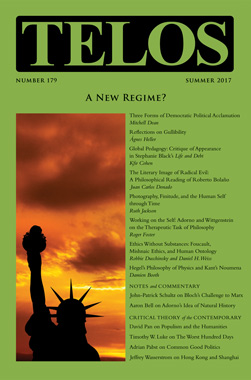Mitchell Dean’s “Three Forms of Democratic Political Acclamation” appears in Telos 179 (Summer 2017). Read the full article at the Telos Online website, or purchase a print copy of the issue in our online store.
 This paper takes its initial inspiration from Carl Schmitt’s claim in 1927 that the “original democratic phenomenon . . . is acclamation,” and draws upon the interchange between religious and political forms of acclamation observed by Ernst Hartwig Kantorowicz and Erik Peterson and elaborated recently by Giorgio Agamben. If Schmitt is correct, then acclamation is central to the construction of “the people” who by definition are the source of political legitimacy. What is required then is what I have called an “analytics of publicity” that would study the different ways in which the public is formed through different forms of acclamation. The paper isolates three such ways. In the first, typified by direct democracy of an authoritarian kind, political acclamation is achieved though the actual presence of the people as assembled public and by hand gestures, waving, and chants. In the second, acclamation takes the form of public opinion formed through the “mass media,” giving rise to the “society of the spectacle.” In the third, acclamation occurs through what is called today “social media,” where it is possible to “follow” and be followed, to “friend” and “unfriend,” like and dislike, and express opinions in a virtual public domain at almost any time and anywhere. All three are present in contemporary liberal democracies. Schmitt had already foreseen something like this situation in his Constitutional Theory (1928), which “would not be an especially intensive democracy, but it would provide proof that the state and the public were fully privatized.”
This paper takes its initial inspiration from Carl Schmitt’s claim in 1927 that the “original democratic phenomenon . . . is acclamation,” and draws upon the interchange between religious and political forms of acclamation observed by Ernst Hartwig Kantorowicz and Erik Peterson and elaborated recently by Giorgio Agamben. If Schmitt is correct, then acclamation is central to the construction of “the people” who by definition are the source of political legitimacy. What is required then is what I have called an “analytics of publicity” that would study the different ways in which the public is formed through different forms of acclamation. The paper isolates three such ways. In the first, typified by direct democracy of an authoritarian kind, political acclamation is achieved though the actual presence of the people as assembled public and by hand gestures, waving, and chants. In the second, acclamation takes the form of public opinion formed through the “mass media,” giving rise to the “society of the spectacle.” In the third, acclamation occurs through what is called today “social media,” where it is possible to “follow” and be followed, to “friend” and “unfriend,” like and dislike, and express opinions in a virtual public domain at almost any time and anywhere. All three are present in contemporary liberal democracies. Schmitt had already foreseen something like this situation in his Constitutional Theory (1928), which “would not be an especially intensive democracy, but it would provide proof that the state and the public were fully privatized.”








